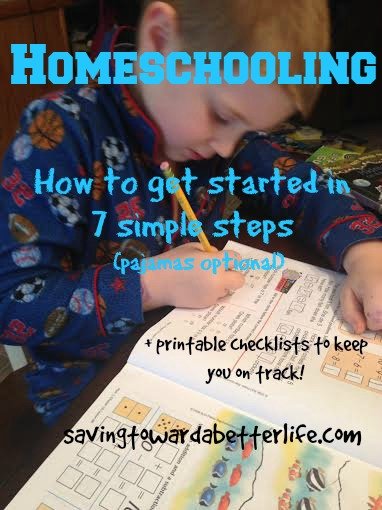You may be asking yourself, how do I get started homeschooling? It is an intimidating thought if you don’t know where to start!
I started homeschooling in 2014 and I’ve been very vocal about starting homeschooling – and my reasons for it – both on my blog and in person to friends, family and acquaintances. (And no, we don’t spend every day in our pajamas.)
People – friends, aquaintances, etc – that are considering homeschooling always approach me apprehensively with their questions. Like they think homechooling is some secret invitation-only society and they’re not sure if they’re allowed to speak of it.
But I let every one know that I am ALWAYS available for questions. I love talking about homeschooling and if I can help others by answering their questions or pointing them in the right direction, then yay!
But I can’t join each of you over cup of coffee in your kitchen or on a park bench during a play date. But if I could here’s what I would tell you if you asked me how you could get started homeschooling your children. Everything is easy when it’s laid out in simple steps to take. And that’s what I’ve done, I’ve given you 7 simple steps to take and a free printable checklist (if you’re so inclined to enjoy checking boxes off a list!) to set you on the right track.
We’re going to skip over the part where you decide if homeschooling is right for you. I’m going under the assumption that you’ve already decided that it is, but are uncertain of the next step.
HOW TO START HOMESCHOOLING
1. Find out your state laws on homeschooling.
You can start looking into your state’s homeschooling laws here. Legal requirements range from no state requlations (in 11 states including Texas, Oklahoma, and Missouri) to low and moderate regulations on up to states with high regulations (5 states including New York, Pennsylvania and Massachusetts).
We’re fortunate to live in a state with low regulations. But don’t let the regulations deter you. Can you homeschool in all 50 states? YES! You can homeschool in all 50 states. Just make sure you know what it legally required by your state to get started.
2. Research.
Hit up your library to see what books they have on homeschooling. My library had a few helpful ones. If you strike out there, you can check out these homeschooling books on Amazon. When you’re selecting books on Homeschooling, take a minute to look at the author’s bio and make sure it’s written by a veteran homeschooler! You want advice from a homeschooler. Not a publishing company writing a book purely for profit without any firsthand knowledge of homeschooling.
3. Reach out to other homeschoolers.
If you know people that homeschool, that’s great! Reach out to them.
If you don’t, check out facebook for homeschool groups. You can find all kinds of online groups where homeschool moms ask questions, get advice and chat. I’m in several groups and everyone is very helpful! So join a group and start asking your questions.
You can also find Facebook groups linked to homeschool groups local to you that organize field trips, play dates, etc. Finding local support is great!
4. Find your curriculum.
To me this was a terribly daunting task. Do you have any idea how much curricula is out there? And we have completely changed course for our second year from what I picked for our first year.
There are tons of great resources to help you find a course of study that matches your child’s abilities, struggles, learning style as well as your family’s budget, lifestyle and beliefs. You can browse this list of books to see if any title jumps out at you. The one I used was 101 Top Picks for Homeschool Curriculum by Cathy Duffy. It has since been updated and now there is a 102 Top Picks for Homeschool Curriculum with updated info and it’s available to order. I think the first one is out of print now.
The Cathy Duffy Books start out by helping you figure out your child’s learning style, which was super helpful!
If you’re curious, we love Sonlight for reading, language arts, history and Bible and Singapore Math, Apologia Science, All About Spelling and Easy Grammar. But it’s important for you to research the choices to make sure they’re a good fit for your family!
5. If your state requires it, find a cover school.
This is something you’ll need in every state except for the 11 states that have no state regulations. Cover school and co-ops are two different things. More on the latter in a minute.
For the states that have regulations they require all children of a certain age (my state just recently lowered it from 7 to 6) to “enrolled in school” This means a public school, private school or a “cover school”. These can also be called “church schools” or “umbrella schools”.
You pay a fee to enroll your child in one of these schools to complete the requirement of having your child enrolled in school. They send a proof of enrollment to your local school board.
Cover schools can be elaborate – organizing field trips and events; some require parent meetings and curriculum approval and a “statement of faith” (for church schools) and quarterly attendance/grade sheets; some offer record keeping (for transcripts) classes, group meetings and electives. The more a cover school offers or requires the more expensive they will be.
Cover schools can be basic and only require a small fee (ours is $25/year) and it provides your proof of enrollment and all I have to do is turn in our attendance yearly.
It all depends on what you want in a cover school.
6. Decide if a co-op (homeschool co-operative) is right for you.
We have a basic cover school but we also live very close to a wonderful co-op. Since I have only one child I knew we needed to get out of the house once a week and be around other kids (not that that’s the only time we get out of the house – we have church, karate and soccer – but I wanted to expanded beyond that and meet other homeschool families)
A homeschool co-operative is a group of homeschooling families that get together and teach classes for their kids. What makes a homeschool co-op work is that every parent in the co-op pitches in. Maybe you know how to sew but you’re terrible at math. You can teach sewing to a small group of girls while your child takes math from someone else. Or if you love babies, you can help in the nursery with the littlest ones so their parents can teach classes. We’ve done two semesters at co-op so far and Bug has taken core things like math and reading as well as fun things like building projects and a LEGO class! Our co-op charges a nominal fee per semester (this covers the cost of using the building we meet in) and classes have supply fees mostly in the $5-$15 range but some of them are higher depending on what’s needed.
Some cover schools offer co-op classes also. Co-op isn’t for everyone. My sister-in-law doesn’t do co-op. She has three schooling at home, two in preschool and a baby. She doesn’t have time. But for us, it’s great, Bug has fun and we’ve made new friends.
7. Decide when you’re going to start and pick a date to “un-enroll” your children from public school. Decide if you need to do some “de-schooling.”
Yes, it is okay to start homeschooling mid-year! If you don’t want to finish out a bad year at public school – don’t! If you’re worried that it’s going to take a few weeks to get your ducks in a row it’s ok to go ahead and take your kids out of school. You may want to spend a few weeks “de-schooling” before you start curriculum. You don’t necessarily have to take them out of school on Friday and start homeschooling on Monday. Especially if they’re having a negative experience at school (bullying, struggling with grades, behavioral problems, anxiety, stress, etc). The first thing you want to do is show them school and learning doesn’t have to be negative or stressful.
What can you do while you’re “de-schooling”? Take a trip to the library and let your child get books they’re interested in reading. Pursue something that interests your child – art, science experiments, bird watching, bug collecting. Field trips – zoo, museums, local historical sites, nature centers. Don’t push the educational aspects of these things, just let your child explore. There will be plenty of time to re-visit these places with notebook in hand to “learn” but to de-school your child, you want to give them time to relax and unwind and see things from a new perspective – without the bullies around, without worrying about what kind of grade they’re going to make, and without being stressed.
Additional things you can do:
- Decide your budget for homeschooling. A good place to start is to take a look at how much you spend on school each year – beginning of the year supplies, class fees, after school activity fees, fundraisers, t-shirts for special events, teacher gifts, lunch money. All this can now be designated for homeschool! You’ll find you probably have a bigger budget to begin with than you thought!
- Attend a homeschool convention, curriculum fair or other event in your area. Here’s a list of events for this year.
- Visit your local teacher’s store. Ask about homeschooling resources. They may even offer homeschooling families a discount like they do for school teachers!
- Consider joining HSLDA (the Home School Legal Defense Association). The cost is $100 per year for your entire family and their mission is to protect your (and everybody else’s) right to homeschool. They offer legal aid to any member who’s rights are being challenged.
Get the printable checklist HERE so you can start checking those things off!
I’d love to hear from you. Is there anything you did when you were starting homeschooling that I left out of this list?















I have found your homeschool planning series helpful! I just read this post and wanted to let you know that not all states that have regulations require an official “cover school.” I live in Colorado. We will begin homeschooling this year. I think technically we are considered a “moderately regulated” state, but all we have to do to “enroll” our kids in homeschool is send a letter of intent 14 days before we start. We are not required to be enrolled anywhere. Just wanted to let you know, since that might be confusing for a few people!
Thanks for your input. That’s why step 1 is finding out your states laws on Homeschooling. Then further down if your state requires it find a cover school.
Hope this clears it up!